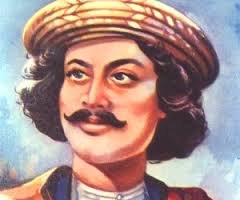 राजा राम मोहन रॉय आधुनिक भारतीय समाज के निर्माताओं मैं प्रमुख हैं . उनका सती प्रथा के उन्मूलन मैं योगदान एक अत्यंत महत्त्व पूर्ण पड़ाव था जिसने रूढ़िवादी परम्पराओं पर पुनर्विचार की आवश्यकता को समझा .परन्तु उस समय के अनेकों चिंतकों की तरह् वह पश्चिम से बहुत प्रभावित थे . परन्तु इसके उपरान्त भी थे पक्के देश भक्त .यह किताब उनके पस्श्चिम के लगाव को अधिक महत्व्देती है . परन्तु उनके समन्वय व्यक्तित्व को समझाने मैं मददगार है.
राजा राम मोहन रॉय आधुनिक भारतीय समाज के निर्माताओं मैं प्रमुख हैं . उनका सती प्रथा के उन्मूलन मैं योगदान एक अत्यंत महत्त्व पूर्ण पड़ाव था जिसने रूढ़िवादी परम्पराओं पर पुनर्विचार की आवश्यकता को समझा .परन्तु उस समय के अनेकों चिंतकों की तरह् वह पश्चिम से बहुत प्रभावित थे . परन्तु इसके उपरान्त भी थे पक्के देश भक्त .यह किताब उनके पस्श्चिम के लगाव को अधिक महत्व्देती है . परन्तु उनके समन्वय व्यक्तित्व को समझाने मैं मददगार है.
Sirlendu Mukherjee , DeLhi University , Pioneer Review AT LINK BELOW
http://www.dailypioneer.com/book-reviews/roys-british-connections.html
Rammohun Roy and the Making of Victorian Britain
Author: Lynn Zastoupil
Publisher: Palgrave, Rs 995
Much has been written on the ‘prophet’ of modern India (irrespective of how you define modernisation), yet for a multi-faceted personality and a polymath like Rammohun Roy, so much had remained unknown. Lynn Zastoupil, a professor of History, at Rhodes College, USA, deals extensively and brilliantly with those less familiar aspects and shows through painstaking research how Roy’s “passions intersected with the projects of reformers and humanitarians in Britain”. He tells us that “rational religion, liberty of the press, constitutional reform, free trade, modern education, the condition of women, and suppression of inhumane practices are causes that Rammohun shared with many Britons”. Zastoupil reminds us that such factors were a preparation for the Victorian Britain or the Age of Reform. Even the masterly works of Asa Briggs (1959), Dorothy Marshall (1962) and Kitson Clark (1962) miss many such strands. In ‘Recovering Roy’s significance for this modernisation project’, he suggests that “Rammohun’s celebrity is a mirror in which the making of Victorian Britain is reflected”.
After the “turbaned Bengali Brahmin” arrived in Liverpool on April 8, 1831, along with his companions and his cows, his “social calendar was filled” through “morning, noon and night”. Roy was already a well-known name in Britain. The author examines the contribution of Unitarians in the making of modern Britain through their campaign for liberty of conscience, freedom of press, civil rights, minority rights, etc. Zastoupil reiterates that Roy’s adoption of the Unitarian identity was always a “fluid entity”, and never a rejection of “rational Hinduism” — more a means to enter the “world of respected middle-class reformers”.
Despite evangelicalism, Britain had space for radical dissent and it provided a niche for Roy. Zastoupil shows how “Abolitionism”, the campaign against slave trade/slavery became a model for the reformers and feminists in Britain and provided “another clue to Roy’s transnational celebrity”. The campaign against Sati in India “parallels the anti-slavery campaigns in key respects” in Britain, and thus helped “forge the idea that Roy was a partner in the moral crusades and spirit of reform sweeping through early 19th century Britain.
Zastoupil suggests that Roy’s emergence as a transnational celebrity was helped by free press and free trade activists. Roy used to send many of his writings and petitions to important people in England, including parliamentarians like Thomas Denman (of the Luddites defence fame) and Col James Young, who voiced his ideas in Parliament; Douglas Kinnaird helped spread his views outside. Both the Whigs and the Radicals saw in Roy “the principle of liberty vindicated”.
Robert Rickards, a parliamentarian and commentator on India, held that liberal institutions were the antidote to centuries of Muslim oppression and opined that Roy’s writings on Christian and Hindu religious themes would “immortalise” his name forever. Roy’s access to Cabinet ministers made Prasanna Kumar Tagore think that Roy was India’s unofficial member of Parliament!
Zastoupil shows how the “global circulation of texts and individuals made it possible for Roy to form intellectual and political alliances in Europe and North America”, to pursue his varied objectives. Moreover, “he wielded the power of satire to bring the coloniser down to the level of the colonised; in Britain, it seems he employed the black arts of ultraradical journalism against the colonial establishment”.
Jeremy Bentham suggested that Roy, “as a representative of British India, a half-caste, and a negro,” should go to Parliament! However, the “Oath” to Christianity factor prevented him from seeking it. Roy, despite his sympathy and understanding of various strands of belief-systems, had remained a Hindu till the end. One may, however, wonder what Zastoupil really means (like some others before) in saying that Tuhfat-ul-Muwahiddin was influenced by “Islamic rationalism”. Tuhfat… was, in fact, a critic of prophetic religions and much more. Certainly, Roy would have faced a fatwa, earned the wrath of ‘progressive’ historians and would have been blacklisted by the ‘secular’ establishment, if he had written this in post-1947 India!
Zastoupil asserts that Roy belonged to “the story of modern Britain” as he was “lionised” by various “groups and individuals” who helped usher in the Victorian Age. A book like this is rarely produced and looks grand with half-a-dozen photographs of this unique personality.
